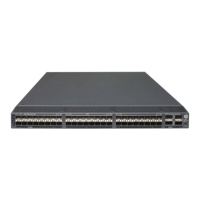130
LAN cannot access the external network. This problem can be solved by establishing a Track-VRRP
group association. Use the detection modules to monitor the status of the uplink of the router and
establish collaborations between the detection modules, Track module, and VRRP. When the uplink
fails, the detection modules notify the Track module to change the status of the monitored track entry
to Negative, and the priority of the master decreases by a user-specified value. This allows a higher
priority router in the VRRP group to become the master, and maintains proper communication
between the hosts in the LAN and the external network.
• Monitor the master on a backup. If a fault occurs on the master, the backup operating in switchover
mode will switch to the master immediately to maintain normal communication.
When VRRP is operating in load balancing mode, associate the Track module with the VRRP VF to
implement the following functions:
• Change the priority of the AVF according to its uplink state. When the uplink of the AVF fails, the
track entry changes to Negative state and the weight of the AVF decreases by a user-specified value
so that the VF with a higher priority becomes the new AVF to forward packets.
• Monitor the AVF status from the LVF. When the AVF fails, the LVF that is operating in switchover
mode becomes the new AVF to ensure continuous forwarding.
Follow these guidelines when you associate Track with VRRP:
• VRRP tracking is not valid on an IP address owner. An IP address owner refers to a router when the
IP address of the virtual router is the IP address of an interface on the router in the VRRP group.
• When the status of the track entry changes from Negative to Positive or NotReady, the associated
router or VF restores its priority automatically.
• You can associate a nonexistent track entry with a VRRP group or VF. The association takes effect
only after you use the track command to create the track entry.
To associate Track with a VRRP group:
Ste
Command
Remarks
1. Enter system view.
system-view N/A
2. Enter interface view.
interface interface-type
interface-number
N/A
3. Associate a track entry with a
VRRP group.
vrrp [ ipv6 ] vrid virtual-router-id
track track-entry-number [ reduced
priority-reduced | switchover ]
No track entry is specified for a
VRRP group by default.
This command is supported when
VRRP is operating in both standard
mode and load balancing mode.
To associate Track with a VRRP VF:
Ste
Command
Remarks
1. Enter system view.
system-view N/A
2. Enter interface view.
interface interface-type
interface-number
N/A

